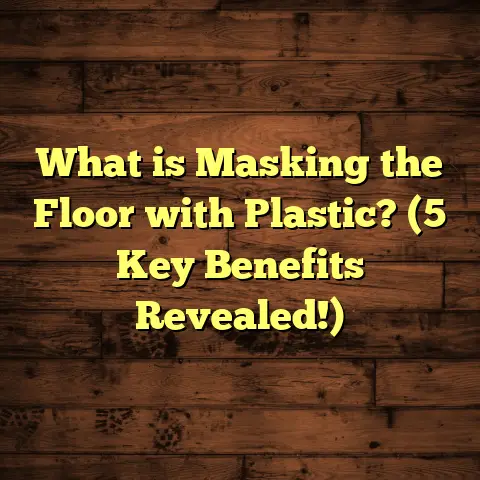What is Laminate Flooring? (5 Benefits You Didn’t Know!)
Have you ever stopped to think about how the floor beneath your feet affects your daily life? How it shapes your home’s atmosphere, your comfort, and even your routines? I bet most people don’t give their floors much thought until something goes wrong or they’re ready to renovate. But for me, flooring is a key part of making a house feel like home. It’s where style meets practicality, and choosing the right material can change everything.
Let me share my journey with laminate flooring—a surprisingly versatile and trustworthy option that I’ve grown to appreciate over the years. Whether you’re considering new floors for your living room, kitchen, or even your basement, laminate might just be the hidden gem you’re missing from your list.
What Exactly Is Laminate Flooring?
To start off, let’s break down what laminate flooring really is. Imagine a product designed to look like natural materials such as hardwood or stone but engineered to offer durability, affordability, and ease of installation. That’s laminate flooring in a nutshell.
At its core, laminate flooring is made up of multiple layers laminated together to form a sturdy plank that mimics the appearance of real wood or stone surfaces. The typical structure includes:
- Core Layer: Usually made from high-density fiberboard (HDF) or medium-density fiberboard (MDF). This dense wood composite provides strength and stability.
- Decorative Layer: A high-resolution photographic image that replicates the look of wood grain, stone textures, or tile patterns.
- Wear Layer: A transparent, tough resin coating (often melamine-based) that protects the plank from scratches, stains, fading, and impacts.
- Backing Layer: This layer adds moisture resistance and balances the plank to prevent warping.
What fascinated me the first time I installed laminate was how these layers come together to create something that feels real without the price tag or maintenance headaches of natural hardwood.
The Science Behind Laminate Flooring
The magic happens during manufacturing when these layers are fused under heat and pressure. This lamination process not only bonds the layers but also gives the floor its name. The wear layer acts as a shield against everyday damage—from pet claws to high heels—and keeps the decorative design looking fresh for years.
One feature I find impressive is the locking mechanism built into the edges of laminate planks. This “click-lock” system allows for floating installation—meaning the floor isn’t glued or nailed down but rather “floats” above the subfloor. This method simplifies installation and also helps accommodate slight movements in the subfloor without cracking or buckling.
Laminate vs. Other Flooring Types
You might wonder how laminate compares to solid hardwood or engineered hardwood floors. While hardwood offers genuine wood grain and long-term refinishing options, it comes with higher costs and greater sensitivity to moisture and scratches.
Laminate captures the look of hardwood but offers:
- Lower cost (typically $2–$5 per square foot vs. $6–$12 for hardwood)
- Easier and faster installation
- Better resistance to scratches and dents
- Less maintenance required
On the flip side, laminate can’t be refinished like hardwood. Once it wears out or gets damaged beyond repair, you’ll need to replace it.
Five Benefits of Laminate Flooring That Might Surprise You
You probably already know laminate is budget-friendly and easy to install. But let me walk you through five benefits I’ve discovered through hands-on experience and research—benefits many people don’t realize at first.
1. Allergy-Friendly Flooring That Helps You Breathe Easier
I had a client who struggled with allergies for years. Their old carpeted rooms were a nightmare when pollen season hit—dust mites and pet dander seemed impossible to control. When we switched their entire home to laminate flooring, they noticed an immediate difference in air quality.
Why? Because laminate is a hard surface that doesn’t trap allergens like carpet does. Dust mites thrive in soft materials where they can settle deep inside fibers. Laminate’s smooth surface makes it easy to sweep or vacuum allergens away daily.
Research supports this too. The American College of Allergy, Asthma & Immunology notes that hard flooring options significantly reduce indoor allergens compared to carpets. In fact, homes with hard surface floors report up to 50% fewer airborne allergens.
For families with asthma or allergy sufferers like mine—laminate can be a game-changer.
2. Remarkable Resistance to Fading Over Time
If your home has large windows or a sunroom flooded with natural light, you might worry about your floors bleaching out or losing their rich colors over time.
Here’s where laminate shines again. Unlike natural wood floors that can fade unevenly under UV rays, laminate flooring is manufactured with UV-resistant coatings in its wear layer. This means it maintains its color vibrancy longer—even when exposed to direct sunlight daily.
I remember installing laminate in a bright breakfast nook surrounded by skylights. After two years, those floors still looked brand new with no noticeable fading—a relief for both me and my client who wanted their floors to look great for years without refinishing.
Data from the North American Laminate Flooring Association confirms that high-quality laminate products can withstand thousands of hours of UV exposure without significant color loss.
3. High Impact Resistance That Keeps Floors Looking New
If you have pets or kids like I do, you know how quickly floors take a beating. Furniture gets dragged around; toys drop hard; shoes scuff relentlessly.
Laminate flooring is designed with a hardwearing surface that resists dents, scratches, and chips far better than hardwood’s softer finishes. In tests by flooring labs, laminate floors have shown an ability to absorb impacts from heavy objects dropped from household heights without permanent damage.
One memorable project involved installing laminate in a family home with two energetic boys and a large dog. After six months of rigorous use—running, jumping, even indoor sports—the floors showed minimal signs of wear compared to nearby hardwood in other rooms.
This durability makes laminate an excellent choice for active households where floors need to keep up with daily life.
4. Environmentally Friendly Options Are Growing Fast
When people hear “laminate,” they sometimes think of synthetic materials that aren’t eco-friendly. But this isn’t always true anymore.
Many manufacturers now focus on sustainability:
- Using recycled wood fibers in their core layers reduces demand for virgin timber.
- Sourcing raw materials from responsibly managed forests.
- Applying water-based adhesives and low-VOC finishes for better indoor air quality.
- Offering floors certified by organizations like FloorScore or GREENGUARD for environmental safety.
In my own work, I’ve helped clients choose laminate brands with certifications guaranteeing social and environmental responsibility.
Plus, because laminate lasts 15–25 years with proper care—comparable to many hardwoods—it reduces waste from frequent replacements common with cheaper flooring types.
5. Predictable Appearance for Consistent Design
If you’re particular about design consistency, laminate has an edge over natural wood’s inherent variability.
Natural hardwood planks show variations in grain patterns, color tones, and knots—even within boards from the same tree species. While some people love this uniqueness, others want uniformity across their floors for a clean modern look.
Laminate uses printed photographic layers that replicate wood grain or stone precisely—with repeatable patterns throughout production batches. This lets designers or homeowners select exact colors and patterns without surprises during installation.
In one design project I managed for a minimalist-style home, choosing laminate allowed us to create seamless herringbone patterns where every plank matched perfectly—something nearly impossible with natural hardwood.
Going Beyond Basics: My Laminate Installation Stories
Over the years as a contractor, I’ve installed hundreds of flooring projects—hardwood, tile, carpet—but laminate holds a special place because of its flexibility and reliability.
Story 1: The Tight Budget Rental Makeover
A client once called me desperate—they had a rental unit in disrepair with outdated carpet stained beyond saving. They needed an affordable solution that wouldn’t break the bank but still looked appealing enough to attract tenants quickly.
We chose mid-range laminate flooring with a dark oak finish. Installation took two days flat—and tenants loved the easy-to-clean surface that felt warm and inviting without carpet odors or stains.
The landlord appreciated how quickly they could turn over units thanks to laminate’s durability and low maintenance needs.
Story 2: The Allergy-Sensitive Family Upgrade
Another memorable case was a family battling asthma and allergies who asked me for flooring advice after years of carpet-related suffering.
Switching their home to laminate made an immediate difference:
- Reduced dust buildup
- Easier cleaning routines
- Happier kids playing on floors without sneezing fits
Their testimonial reinforced what I’d read about allergy benefits—and gave me renewed confidence recommending laminate for health-conscious clients.
Story 3: The Sunroom Transformation
I also worked on converting a sunroom into an all-season living space. Because this room had large windows and lots of sunlight pouring in daily, selecting flooring that wouldn’t fade was critical.
Laminate was the ideal choice because of its UV resistance and ability to handle temperature swings better than hardwood or vinyl.
After installation, the homeowners enjoyed vibrant floors year-round without worrying about sun damage—a problem they’d faced before with previous flooring types.
Digging Deeper: Data & Research on Laminate Flooring Performance
To give you a clearer picture based on facts:
| Feature | Laminate Flooring | Hardwood Flooring |
|---|---|---|
| Average Material Cost | $2 – $5 per sq ft | $6 – $12 per sq ft |
| Installation Time | 1–2 days per 1,000 sq ft (pro install) | 3–5 days per 1,000 sq ft |
| Lifespan | 15–25 years (with care) | 25+ years (can be refinished) |
| Scratch Resistance | High (melamine wear layer) | Moderate (wood finish vulnerable) |
| Moisture Resistance | Moderate (not waterproof) | Low (susceptible to water damage) |
| UV Resistance | High (UV-stable coating) | Varies widely by species |
| Environmental Impact | Increasingly green options available | Depends on sourcing |
| Allergy-Friendliness | Excellent (hard surface reduces allergens) | Good (hard surface but porous wood) |
Source: North American Laminate Flooring Association (NALFA), American Lung Association Studies
What About Installation? My Tips & Tricks
One reason I recommend laminate so often is how straightforward it is to install—even for DIYers willing to learn some basics.
Here are some tips I’ve picked up:
- Acclimate planks: Let the flooring sit in the room for 48 hours before installation so it adjusts to temperature and humidity.
- Use underlayment: Most laminate requires foam or cork underlayment for cushioning, moisture barrier, and soundproofing.
- Leave expansion gaps: Floors expand and contract naturally; leaving small gaps around edges prevents buckling.
- Use proper tools: A tapping block and pull bar help fit planks snugly without damage.
- Work in rows: Stagger seams like bricklaying for stability and aesthetics.
I’ve seen first-timers get great results following these steps—and professional installers usually finish projects faster than any other floor type due to click-lock systems.
Caring for Your Laminate Floors Over Time
Once installed, keeping laminate floors looking new isn’t complicated:
- Sweep or vacuum regularly using soft bristle attachments.
- Mop occasionally with damp cloths—not soaking wet—to avoid moisture damage.
- Use floor protectors under furniture legs to prevent scratches.
- Clean spills immediately.
- Avoid abrasive cleaners or waxes that can dull the wear layer.
In my experience advising clients on maintenance has saved them hundreds in repairs by preventing small issues from becoming big problems.
Can Laminate Flooring Be Used Everywhere?
While versatile, I don’t recommend laminate flooring in certain areas:
- Bathrooms or areas prone to standing water: Laminate isn’t waterproof; prolonged moisture can cause swelling.
- Outdoor spaces: Exposure to elements isn’t suitable.
However, for kitchens, basements (with proper moisture control), living rooms, bedrooms—laminate works beautifully when installed correctly and maintained well.
Final Thoughts – Should You Choose Laminate?
Are you leaning toward laminate after all this? If you value affordability without sacrificing style; want something tough enough for busy households; prefer allergy-friendly options; need UV resistance; or want consistent flooring design—laminate deserves serious consideration.
I still recommend weighing your specific needs:
- Will you refinish floors later? If yes, hardwood might be better.
- How much moisture exposure will there be?
- What’s your budget?
Answering these helps make an informed choice.
If you decide on laminate flooring—or if you’re curious about other options—I’m here anytime to answer questions or offer guidance based on real-world experience.
Remember: Your floor sets the foundation for every room in your home. Choose one that fits your lifestyle as much as your style!
Would you like help picking brands or styles? Or want step-by-step installation guidance? Just ask!





